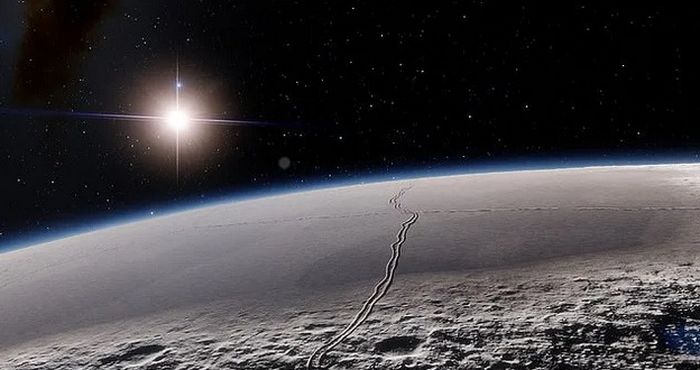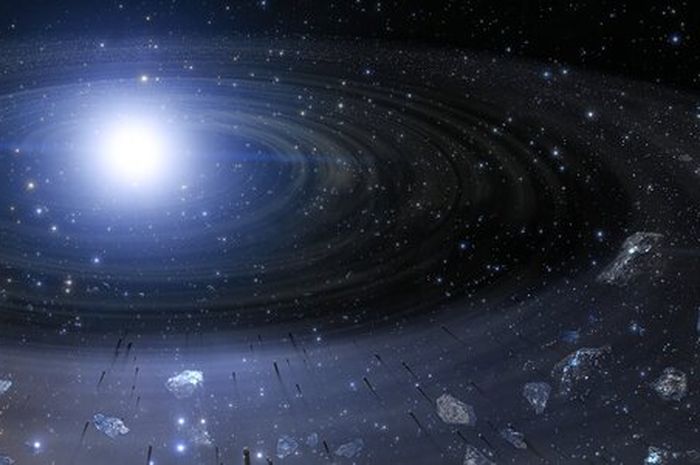M. Zamani and M. Kosari
–
Illustration of Rocky Rubble around a white dwarf.
–
Nationalgeographic.co.id – The team of scientists, a collaboration of astronomers and geologists, found that most of the rocky planet orbiting nearby stars is more diverse and exotic than previously thought. These planets have rock types found nowhere else in our solar system.
The research is the first to study and estimate the type of rock present on a planet orbiting a nearby star. Details of this study have been published in the journal Nature Communications by title “Polluted white dwarfs reveal exotic mantle rock types on exoplanets in our solar neighborhood“.
In this study, an astronomer from NSF’s NOIRLab has teamed up with a geologist from California State University, Fresno, to study the chemical composition white dwarf “polluted”. They then made the first estimates of the rock types present on planets orbiting nearby stars.
It was explained, that until now astronomers have found thousands of planets orbiting stars in our galaxy, known as eksoplanet. However, it is difficult to know exactly what these planets are made of, or whether any resemble Earth.
Next page…
To try to find out, astronomer Siyi Xu of NSF’s NOIRLab partnered with geologist Keith Putirka of California State University, Fresno, to study the atmosphere known as white dwarf polluted. It is a planet with a solid core and is a fragment of a once normal star like the Sun. These objects used to contain foreign matter from planets, asteroids, or other rocky bodies that once orbited stars but eventually became stars white dwarf and “contaminate” the atmosphere.
By searching for elements that would not exist naturally in the atmosphere white dwarf (in addition to hydrogen and helium), scientists can find out where and what objects are made of rocky planet that fell on the star.
Putirka and Xu observe 23 white dwarf polluted, all within about 650 light years from the Sun. The object in which calcium, silicon, magnesium and iron have been measured with precision using the WM Keck Observatory in Hawai’i, the Hubble Space Telescope, and other observatories.
Also Read: Weird Exoplanets Like Neptune May Have Water Clouds

Shutterstock
–
Artist’s view of an exoplanet, with its stars in the background. So far, astronomers have discovered thousands of exoplanets orbiting another star in our galaxy, the Milky Way.
–
Scientists then use measured abundances of those elements to reconstruct the minerals and rocks that would form from them. They discovered that these white dwarfs have a much wider composition than any of the inner planets in our Solar System. This indicates that the planets have a wider variety of rock types. In fact, it turns out that some compositions are so unusual that Putirka and Xu had to come up with new names (such as “quartz pyroxenites” and “periclase dunites”) to classify new rock types that must have existed on the planet.
“While some exoplanets that have orbited polluted white dwarfs appear similar to Earth, most have exotic rock types compared to our solar system,” Xu said in the release of NSF’s NOIRLab.
Meanwhile, Putirka explains what this new rock type means for the rocky world they are in. “Some of the rock types we see from the white dwarf data will dissolve more water than rocks on Earth and may have an impact on how the oceans develop,” he explained.
He continued, he thinks some types of rock may melt at much lower temperatures and produce a thicker crust than Earth’s rock. And some rock types may be weaker, which may facilitate the development of plate tectonics.
Previous studies of polluted white dwarfs have found elements from rocky planets, including calcium, aluminum and lithium. However, Putirka and Xu explained that it is a minor element that usually makes up a small portion of Earth’s rock) and measurements of the major elements that make up most of Earth’s rock, especially silicon.
Also Read: Beyond Our Solar System, This Planet Is Like A Giant Cannonball

Jon Kelvey/Inverse
–
Studies of white dwarfs feeding on their planets suggest that the types of rocks and minerals that make up exoplanets are stranger than scientists thought.
–
In addition, Putirka and Xu state that the high levels of magnesium and low levels of silicon measured in the white dwarf’s atmosphere suggest that the rocky debris detected may have come from the planet’s interior, from the mantle, not the crust. Several previous studies of polluted white dwarfs reported signs that continental crust existed on rocky planets that once orbited those stars, but Putirka and Xu found no evidence of crustal rock.
However, observations do not completely rule out that the planets have continental crust or some other type of crust. “We believe that if there is crustal rock, we can’t see it, perhaps because it occurs in too small a fraction compared to the mass of other planetary components, such as the core and mantle, to measure,” Putirka said.
According to Xu, the pair of astronomers and geologists is the key to unlocking the secrets hidden in the polluted atmosphere of white dwarfs. “I met Keith Putirka at a conference and was delighted he could help me understand the system I was observing. He taught me geology and I taught him astronomy, and we found a way to understand this mysterious exoplanetary system,” he said.
Also Read: Astronomers: One Year on this Exoplanet Equals 18 Earth Hours
PROMOTED CONTENT
Featured Videos
– .


